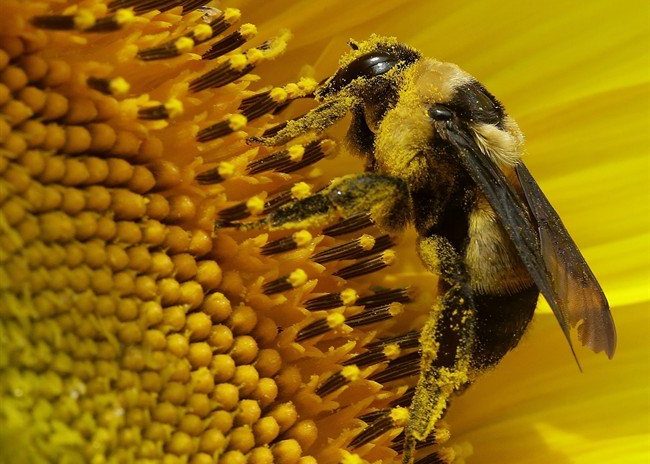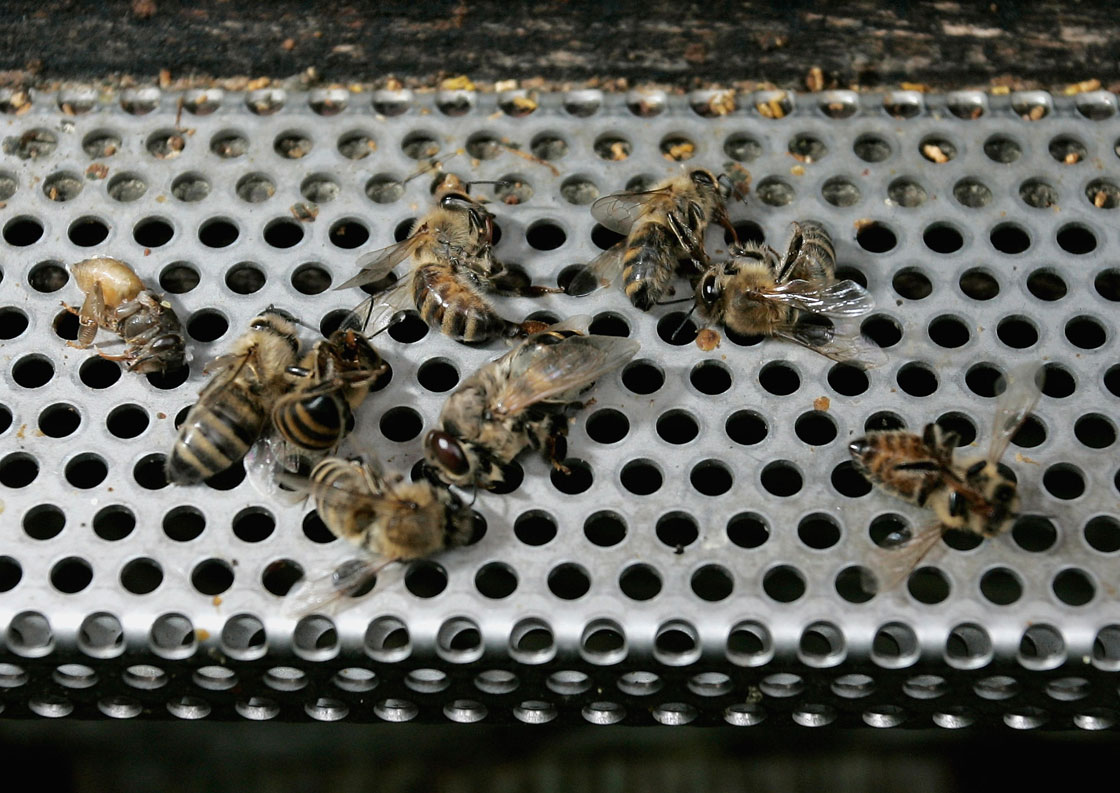TORONTO – Davis Bryans is a fourth-generation beekeeper at Munro Honey in Alviston, Ontario. It’s a lifestyle he loves. It may be a long day – 12 to 14 hours in the summer – but he’s outside, learning about the natural world around him and watching as life flourishes season by season.

But what he’s noticed lately is that life is declining around him. In particular, that of insects.
For the past six years or so, Bryans has noticed a steep decline in his bee crop.
“We’re out the environment and we’re really noticing other pollinators that aren’t there,” Bryans said. “Like the leaf-cutter bee, the bumble bee, the butterflies…they’re just not there.”
And it’s not just his crop, others are also in decline. The culprit responsible, Bryans believes – along with other beekeepers around the world – are neonicotinoids, known as neonics or NNIs. In fact, in 2013, the European Union put a temporary ban on NNIs.
READ MORE: EU bans pesticides in effort to save bees
The first time Bryans started to notice something was wrong was around 2007. His crop was declining, but cropping practices had remained the same.
- High benzene levels detected near Ontario First Nation for weeks, residents report sickness
- Meta says you can’t turn off its new AI tool on Facebook, Instagram
- Enter at your own risk: New home security camera aims paintballs at intruders
- Beijing orders Apple to pull WhatsApp, Threads from its China app store
He and other beekeepers in the same area were perplexed.
Bryans tried replacing the queens. But that didn’t stop the bees from dying, sometimes a twitching mess in front of the hive, sometimes just laying dead in a pile.
Finally, in 2012, the Pest Management Regulatory Agency (PMRA), a branch of Health Canada, sent investigators to the region from both the Ontario Ministry of Environment and the Ministry of Agriculture, Food and Rural Affairs (OMAFRA).
The report from this investigation was published in October 2013. In part, it read:
“The information evaluated suggests that planting of corn seeds treated with the nitro-guanidine insecticides clothianidin and/or thiamethoxam contributed to the majority of the bee mortalities that occurred in corn growing regions of Ontario and Quebec in Spring 2012…The unusual weather conditions in the spring of 2012 were likely also a contributing factor.”
Clothianidin and thiamethoxam are two types of insecticides. Part of the neonicotinoid (NNI) family, they are used on about 95 per cent of corn crops in Canada and the U.S., as well as about 70 per cent of soy. The report clearly identified the pesticide as contributing to the majority of bee losses in a key region of corn and soy production. But there was no ban.
Then in July 2014, the Ontario government made an unprecedented move: the Liberal government confirmed that it was seeking to restrict the use of these pesticides.
But for some beekeepers, it wasn’t enough. That’s why on Sept. 3, a proposed class-action lawsuit was launched against Bayer AG and Syngenta, two major manufacturers of neonics. Two of the beekeepers involved in the $450 million lawsuit were Munro Honey and Sun Parlour Honey.
Ontario beekeeper Tibor Szabo said that he plans on joining the lawsuit as well.
“I have been heavily affected by these chemicals for sure,” he said. This year, he’s lost 1,165 hives, each with 1000 bees.
READ MORE: California honey production dries up amid record drought
Szabo is a third-generation beekeeper. His father, once a leading bee research scientist, was awarded the Order of Canada in 1987 for his work with bees.
Trying to make a living
Both Bryans and Szabo question why NNIs are being used straight across the board when not all farmers may need it.
“To put it on 100 per cent of crops without knowing if they need it?” Bryans said. “That’s a crime.”
“It’s mobile, persistent and systemic,” Szabo said. “Putting it on every agricultural field in southern Ontario is nothing but insanity.”
And the use of the pesticides, these men believe, is making it harder to run their businesses.
“We try to run 2,700 hives,” Bryans said. In each of those hives there are 80,000 bees. “But it’s hard to keep those numbers up.”
For Szabo, who raises queens, this year he was only able to produce 2,000. He used to be able to produce 6,000-7,000.
“We just can’t keep the hives going,” he said.
The dismaying part is that bee losses used to be largely relegated to winter, but that is no longer the case. At any point during the year, Szabo is faced with the possibility that a large part of his crop is dead or unhealthy. And Szabo lays the blame on NNIs.
“It has to stop. It just has to stop.”
The key to keeping their businesses going, both men agree, is diversifying.
“You do what you can,” Szabo said. “You have to adjust and do different things, but it’s crazy.”
Bryans said that his losses are making his business more costly and labour-intensive. One example is trying to find a sick bee in 2,700 hives.
“You have to go down and try to find that one bee in 80,000. It’s very labour-intensive. It’s gotten to the point…we’re having a hard time of it.”
Bee losses across Ontario this past year are estimated to be around 58 per cent, Szabo said. While some may blame last winter – a particularly long and harsh one – Szabo said that it’s not the winter. It’s that unhealthy bees – bees that are “essentially brain damaged” – can’t make it through the winter. They lose their ability to function properly – such as clustering to stay warm.
And don’t try to tell him it could be varroa mites, a mite that can be lethal to bees.
“Poisoning symptoms are so, so different,” he said.
As for the lawsuit – put before the courts by Munro Honey and Sun Parlour Honey – Bryans said that he feels like there was little else he could do.
“When your back is up against the wall you’ve got to do something. And if they’re going to take our industry away, they’re going to have to pay us to do it. But I don’t think the average person wants this industry gone.”
“We feel if we don’t say anything, the rest of the environment is suffering,” Bryans said.
CropLife, who represents the manufacturers of these pesticides, declined to comment on the suit.
Syngenta only issued a release that read in part, “While Syngenta has not received the complaint in question and cannot comment on any specifics, we do take concerns about bee health very seriously. The scientific evidence, including field studies conducted in Canada, clearly shows that bees and other pollinators can coexist safely with modern agricultural technologies, including neonicotinoids.”
But both men hope that the lawsuit will stop the widespread use of these pesticides.
READ MORE: U.S. wildlife refuges phasing out GMO crops, some pesticides to help bees
“I would like to see, realistic and proper risk-assessment on all insecticides, especially systemic insecticides, before any of it is released,” Szabo said. “This stuff shouldn’t happen… Regulators need to get with the program. I’d like to see some accountability from the federal government.”
Bryans said that bees – believed to be responsible for more than half of the world’s pollination – are too important to lose.
“They pollinate stuff that you hardly even realize that they’re pollinating, like wild flowers, maple trees, clovers, hay in the hay fields,” he said. “It’s very important and we feel like we’re doing a service to the environment.”




Comments